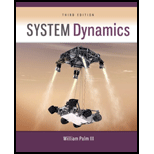
Concept explainers
(a)
Whether the given differential equation is linear or non-linear with supportive reason.
Answer to Problem 2.1P
As, here, derivative of dependent variable is multiplied with itself.
Explanation of Solution
Given:
Concept Used:
An ordinary differential for
where the ‘coefficient’ functions
In other words a differential equation is said to be linear if and only if the derivative of dependent variable should not be multiplied with dependent variable itself, otherwise it should be non-linear.
Calculation:
Given differential equation is
Which is a non-linear differential equation.
As, here, derivative of dependent variable is multiplied with itself.
(b)
Whether the given differential equation is linear or non-linear with supportive reason.
Answer to Problem 2.1P
As, here, derivative of dependent variable is not multiplied with itself.
Explanation of Solution
Given:
Concept Used:
An ordinary differential for
where the ‘coefficient’ functions
In other words a differential equation is said to be linear if and only if the derivative of dependent variable should not be multiplied with dependent variable itself, otherwise it should be non-linear.
Calculation:
Given differential equation is
(c)
Whether the given differential equation is linear or non-linear with supportive reason.
Answer to Problem 2.1P
As, here, derivative of dependent variable is not multiplied with itself.
Explanation of Solution
Given:
Concept Used:
An ordinary differential for
where the ‘coefficient’ functions
In other words a differential equation is said to be linear if and only if the derivative of dependent variable should not be multiplied with dependent variable itself, otherwise it should be non-linear.
Calculation:
Given differential equation is
As, here, derivative of dependent variable is not multiplied with itself.
(d)
Whether the given differential equation is linear or non-linear with supportive reason.
Answer to Problem 2.1P
is a non-linear differential equation.
As, here, derivative of dependent variable is multiplied with itself.
Explanation of Solution
Given:
Concept Used:
An ordinary differential for
where the ‘coefficient’ functions
In other words a differential equation is said to be linear if and only if the derivative of dependent variable should not be multiplied with dependent variable itself, otherwise it should be non-linear.
Calculation:
Given differential equation is
Which is a non-linear differential equation.
As, here, derivative of dependent variable is multiplied with itself.
(e)
Whether the given differential equation is linear or non-linear with supportive reason.
Answer to Problem 2.1P
As, here, derivative of dependent variable is multiplied with independent variable.
Explanation of Solution
Given:
Concept Used:
An ordinary differential for
where the ‘coefficient’ functions
In other words a differential equation is said to be linear if and only if the derivative of dependent variable should not be multiplied with dependent variable itself, otherwise it should be non-linear.
Calculation:
Given differential equation is
Which is a non-linear differential equation.
As, here, function of dependent variable is multiplied with independent variable.
(f)
Whether the given differential equation is linear or non-linear with supportive reason.
Answer to Problem 2.1P
As, here, function of dependent variable is not multiplied with independent variable.
Explanation of Solution
Given:
Concept Used:
An ordinary differential for
where the ‘coefficient’ functions
In other words a differential equation is said to be linear if and only if the derivative of dependent variable should not be multiplied with dependent variable itself, otherwise it should be non-linear.
Calculation:
Given differential equation is
which is a linear differential equation.
As, here, function of dependent variable is not multiplied with independent variable.
Want to see more full solutions like this?
Chapter 2 Solutions
System Dynamics
- (◉ Home - my.uah.edu Homework#5 MasteringEngineering Mastering X + 8 https://session.engineering-mastering.pearson.com/myct/itemView?assignmentProblemID=18992147&offset=nextarrow_forward(read image)arrow_forward(read image)arrow_forward(◉ Home - my.uah.edu Homework#5 MasteringEngineering Mastering X + 8 https://session.engineering-mastering.pearson.com/myct/itemView?assignmentProblemID=18992148&offset=nextarrow_forward(◉ Home - my.uah.edu Homework#5 MasteringEngineering Mastering X + 8 https://session.engineering-mastering.pearson.com/myct/itemView?assignmentProblemID=18992144&offset=nextarrow_forwardCalculate the forces in members BC, BG & FG of the truss shown using the Method of Sections. For your answer, provide atruss diagram of the calculated member forces and indicate whether the member is in Tension (+) or Compression (-)arrow_forwardarrow_back_iosSEE MORE QUESTIONSarrow_forward_iosRecommended textbooks for you
 Elements Of ElectromagneticsMechanical EngineeringISBN:9780190698614Author:Sadiku, Matthew N. O.Publisher:Oxford University Press
Elements Of ElectromagneticsMechanical EngineeringISBN:9780190698614Author:Sadiku, Matthew N. O.Publisher:Oxford University Press Mechanics of Materials (10th Edition)Mechanical EngineeringISBN:9780134319650Author:Russell C. HibbelerPublisher:PEARSON
Mechanics of Materials (10th Edition)Mechanical EngineeringISBN:9780134319650Author:Russell C. HibbelerPublisher:PEARSON Thermodynamics: An Engineering ApproachMechanical EngineeringISBN:9781259822674Author:Yunus A. Cengel Dr., Michael A. BolesPublisher:McGraw-Hill Education
Thermodynamics: An Engineering ApproachMechanical EngineeringISBN:9781259822674Author:Yunus A. Cengel Dr., Michael A. BolesPublisher:McGraw-Hill Education Control Systems EngineeringMechanical EngineeringISBN:9781118170519Author:Norman S. NisePublisher:WILEY
Control Systems EngineeringMechanical EngineeringISBN:9781118170519Author:Norman S. NisePublisher:WILEY Mechanics of Materials (MindTap Course List)Mechanical EngineeringISBN:9781337093347Author:Barry J. Goodno, James M. GerePublisher:Cengage Learning
Mechanics of Materials (MindTap Course List)Mechanical EngineeringISBN:9781337093347Author:Barry J. Goodno, James M. GerePublisher:Cengage Learning Engineering Mechanics: StaticsMechanical EngineeringISBN:9781118807330Author:James L. Meriam, L. G. Kraige, J. N. BoltonPublisher:WILEY
Engineering Mechanics: StaticsMechanical EngineeringISBN:9781118807330Author:James L. Meriam, L. G. Kraige, J. N. BoltonPublisher:WILEY
 Elements Of ElectromagneticsMechanical EngineeringISBN:9780190698614Author:Sadiku, Matthew N. O.Publisher:Oxford University Press
Elements Of ElectromagneticsMechanical EngineeringISBN:9780190698614Author:Sadiku, Matthew N. O.Publisher:Oxford University Press Mechanics of Materials (10th Edition)Mechanical EngineeringISBN:9780134319650Author:Russell C. HibbelerPublisher:PEARSON
Mechanics of Materials (10th Edition)Mechanical EngineeringISBN:9780134319650Author:Russell C. HibbelerPublisher:PEARSON Thermodynamics: An Engineering ApproachMechanical EngineeringISBN:9781259822674Author:Yunus A. Cengel Dr., Michael A. BolesPublisher:McGraw-Hill Education
Thermodynamics: An Engineering ApproachMechanical EngineeringISBN:9781259822674Author:Yunus A. Cengel Dr., Michael A. BolesPublisher:McGraw-Hill Education Control Systems EngineeringMechanical EngineeringISBN:9781118170519Author:Norman S. NisePublisher:WILEY
Control Systems EngineeringMechanical EngineeringISBN:9781118170519Author:Norman S. NisePublisher:WILEY Mechanics of Materials (MindTap Course List)Mechanical EngineeringISBN:9781337093347Author:Barry J. Goodno, James M. GerePublisher:Cengage Learning
Mechanics of Materials (MindTap Course List)Mechanical EngineeringISBN:9781337093347Author:Barry J. Goodno, James M. GerePublisher:Cengage Learning Engineering Mechanics: StaticsMechanical EngineeringISBN:9781118807330Author:James L. Meriam, L. G. Kraige, J. N. BoltonPublisher:WILEYThermodynamics: Maxwell relations proofs 1 (from ; Author: lseinjr1;https://www.youtube.com/watch?v=MNusZ2C3VFw;License: Standard Youtube License
Engineering Mechanics: StaticsMechanical EngineeringISBN:9781118807330Author:James L. Meriam, L. G. Kraige, J. N. BoltonPublisher:WILEYThermodynamics: Maxwell relations proofs 1 (from ; Author: lseinjr1;https://www.youtube.com/watch?v=MNusZ2C3VFw;License: Standard Youtube License